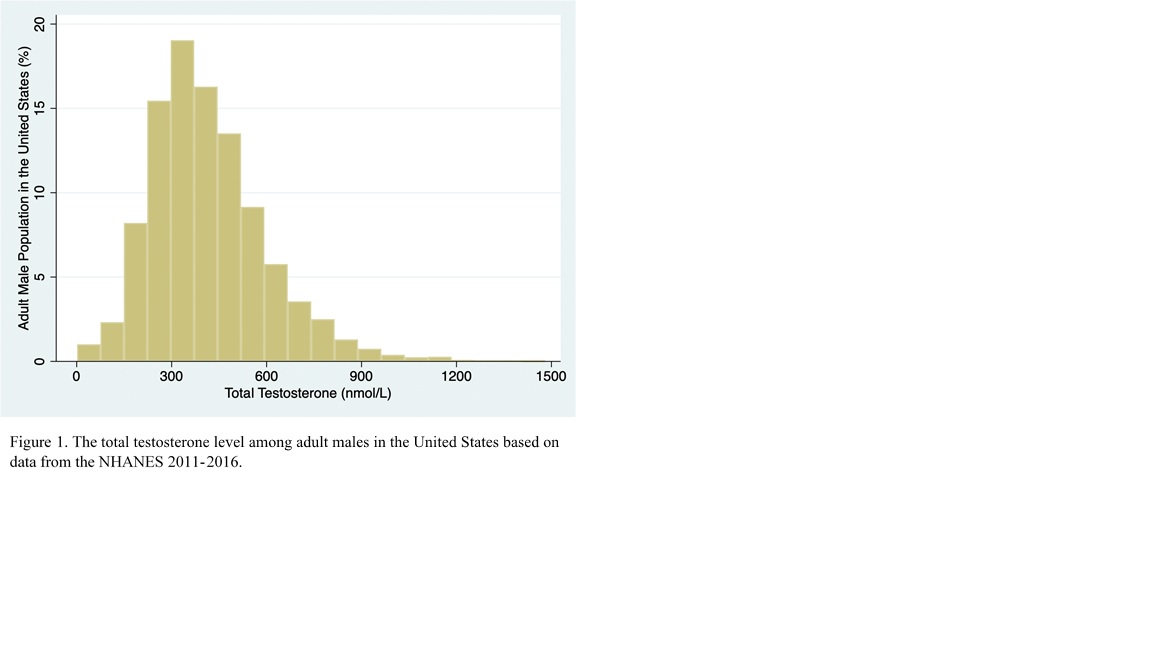Back
Poster, Podium & Video Sessions
Podium
PD09: Infertility: Epidemiology & Evaluation I
PD09-08: Prevalence and Predictors of Testosterone Deficiency Among Adult Men in the United States.
Friday, May 13, 2022
2:10 PM – 2:20 PM
Location: Room 252
John Ernandez*, Steven Chang, Martin Kathrins, Boston, MA
- JE
Podium Presenter(s)
Introduction: Testosterone deficiency is associated with higher risks of morbidity and mortality. Prior studies that estimated the prevalence of testosterone deficiency in the US either used region-restricted data or were conducted in specific clinical settings. This study aimed to estimate the contemporary prevalence and predictors of testosterone levels in the United States among adult men using a contemporary, population-based cohort.
Methods: Using the Continuous National Health and Nutrition Examination Survey (NHANES) 2011-2016, we limited our study cohort to men =18 years old. Testosterone deficiency was defined as total testosterone <300 ng/dL. Descriptive analyses were employed for sociodemographic and clinical information. Multivariable logistic regression was performed to identify predictors of testosterone deficiency. All statistical analyses were performed with survey weighting to achieve a nationally representative estimation based on the United States Census 2020.
Results: The study cohort was comprised of 8,354 men with 26.6% with testosterone deficiency approximating 33.1 million men (Figure 1). The median total testosterone was 393.2 ng/dL (interquartile range, 292.7-516.6 ng/dL) for the study cohort. After adjusting for sociodemographic and clinical characteristics, predictors of testosterone deficiency included age (increasing decade of age: odds ratio (OR) 1.13, 95% confidence interval (CI) 1.02-1.23, p=0.009), obesity (Class I, OR: 1.63, 95% CI: 1.22-2.18, p=0.001; Class II, OR: 3.97, 95% CI: 2.7-5.82, p<0.001; Class III, OR: 9.7, 95% CI: 5.62-16.74, p<0.001), and metabolic syndrome (OR: 2.12, 95% CI: 1.57-2.87, p<0.001).
Conclusions: Testosterone deficiency is widespread in the United States affecting over one-quarter of adult men. It is closely associated with increasing age as well as modifiable factors including obesity and metabolic syndrome. The prevalence of testosterone deficiency will likely increase in the future, given the aging population and obesity epidemic.
Source of Funding: None.

Methods: Using the Continuous National Health and Nutrition Examination Survey (NHANES) 2011-2016, we limited our study cohort to men =18 years old. Testosterone deficiency was defined as total testosterone <300 ng/dL. Descriptive analyses were employed for sociodemographic and clinical information. Multivariable logistic regression was performed to identify predictors of testosterone deficiency. All statistical analyses were performed with survey weighting to achieve a nationally representative estimation based on the United States Census 2020.
Results: The study cohort was comprised of 8,354 men with 26.6% with testosterone deficiency approximating 33.1 million men (Figure 1). The median total testosterone was 393.2 ng/dL (interquartile range, 292.7-516.6 ng/dL) for the study cohort. After adjusting for sociodemographic and clinical characteristics, predictors of testosterone deficiency included age (increasing decade of age: odds ratio (OR) 1.13, 95% confidence interval (CI) 1.02-1.23, p=0.009), obesity (Class I, OR: 1.63, 95% CI: 1.22-2.18, p=0.001; Class II, OR: 3.97, 95% CI: 2.7-5.82, p<0.001; Class III, OR: 9.7, 95% CI: 5.62-16.74, p<0.001), and metabolic syndrome (OR: 2.12, 95% CI: 1.57-2.87, p<0.001).
Conclusions: Testosterone deficiency is widespread in the United States affecting over one-quarter of adult men. It is closely associated with increasing age as well as modifiable factors including obesity and metabolic syndrome. The prevalence of testosterone deficiency will likely increase in the future, given the aging population and obesity epidemic.
Source of Funding: None.


.jpg)
.jpg)